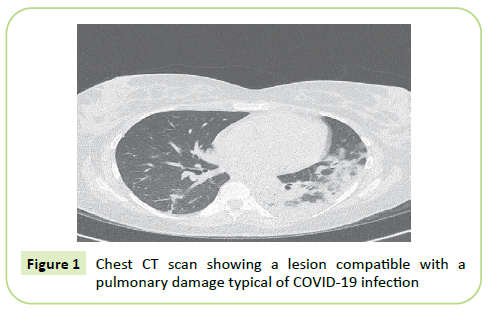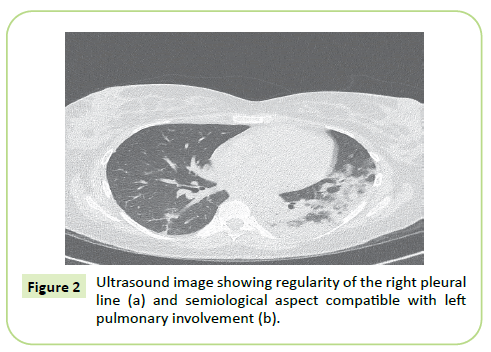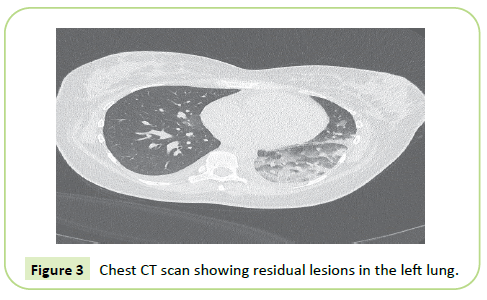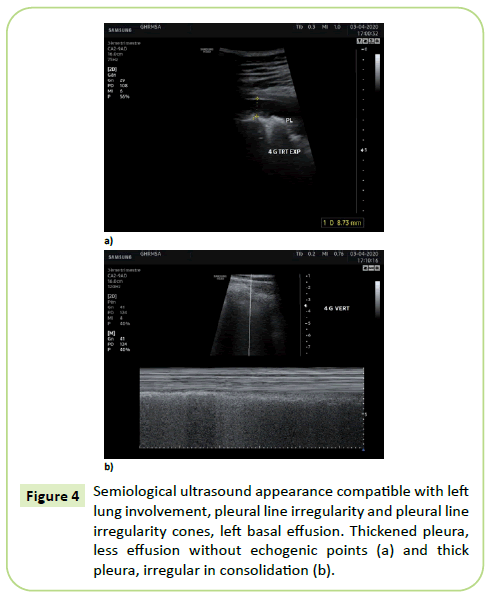Montoya Ramirez EY*, Gilliot C, Puygrenier M, Kacem R, Schaub M, Homatter C and Amancei S
Department of Obstetrics, Fetal Medicine and Ultrasound Unit, Hospital Group of the Mulhouse and South Alsace Region, Woman-Mother-Child Hospital, Mulhouse, France
- Corresponding Author:
- Montoya Ramirez EY
Hospital Practitioner, Department of Obstetrics
Fetal Medicine and Ultrasound Unit
Hospital Group of the Mulhouse and South Alsace Region
Woman-Mother-Child Hospital 69 Rue du Dr. Léon Mangeney
68100 Mulhouse, France
Tel: 33[0)389646970
E-mail: montoyaramireze@ghrmsa.fr
Received Date: April 27, 2020; Accepted Date: May 21, 2020; Published Date: May 26, 2020
Citation: Montoya Ramirez EY, Gilliot C, Puygrenier M, Kacem R, Schaub M, et al. (2020) Lung Ultrasound for Rapid Diagnosis of COVID-19-Induced Pulmonary Pathology: A Case Report of a Pregnant Infected Woman. Gynecol Obstet Case Rep Vol.6 No.2:16 doi:10.36648/2471-8165.6.2.0S1
Keywords
Lung ultrasound; COVID-19; Pregnant woman; Lung infection; CT scan
Introduction
Currently, the gold standard for the etiological diagnosis of
COVID-19 infection is the RT-PCR of samples from the respiratory
tract. However, there is a significant rate of false negative
results linked to the sampling method or to the viral load, 30-
40% according to certain studies [1]. In this context, a rapid and
reproducible diagnostic orientation can favour a reduction in the
number of COVID-19 false negative patients before the clinical
picture worsens.
Lung ultrasound is vast area of interest, with several aspects and
specialties, particularly when applied to pregnant women. It’s a
non-irradiating examination with easy access to the patient's bed
that’s inexpensive and available in all countries including in third
world countries.
Since the 1990s, various teams have highlighted the advantages
that lung ultrasound brings to diagnosis of acute pulmonary
involvement in patients hospitalized in intensive care units [2,3].
Recently, this was underscored in the context of viral infection
with SARS-Cov2 [4].
The availability of this technique, its ease of learning and its
immediate accessibility to any obstetric team on call means that
lung ultrasound can provide a rapid response in an emergency
without the risk of maternal-foetal radiation. It makes possible
deferring biology and computed tomography: the only reliable
diagnostic methods currently recommended.
For these reasons the Italian team of Francesca Moro has proposed
to integrate lung ultrasound into the hierarchy of diagnostic tools
to allow rapid sorting and appropriate management of suspected or confirmed for COVID-19 pregnant patients [4]. Indeed, Lung
ultrasound brings several advantages including availability, safety,
speed, reduced cost, increased comfort for the patient and above
all the absence of radiation in an obstetric context. Starting from
the concrete example of a patient, we present the ease, safety
and relevance of lung ultrasound, as a diagnostic orientation tool
for pulmonary involvement in pregnant women in the context of
COVID-19 infections.
Case Report
A 32-year-old patient was referred [03/25/2020] by her
gynaecologist to obstetric emergencies and presented with
38°C of fever [first episode 03/22/2020], a cough and fatigue
with difficulty in breathing. It was a third pregnancy and and her second had a history of a scar uterus for obstructed labour and an
instrumental vaginal delivery. The current pregnancy had a start
date of 08/25/2019 and is marked by gestational diabetes.
Faced with a reassuring clinical picture [normal maternal
pulmonary auscultation, O2 saturation at 99%, foetal heart rate
without particularities) a test sample for COVID-19 was taken and
the patient received instructions for daily home and telephone
follow-up according to the current COVID-19 suspected case
management protocol.
The sample returns two days later negative for COVID-19. Seven
days after the symptoms declared, the clinical evolution of the
patient required hospitalization on 03/30/2020 at 33 weeks of
amenorrhea:
Clinically, there was significant asthenia, slight dyspnea and
hyperthermia at 39.7°C. Free and symmetrical pulmonary
auscultation, with an O2 saturation of 97-100%. Testing for
COVID-19 was redone and found to be positive. A complete
infection assessment was carried out and treatment with
amoxicillin initiated.
Concerning obstetrics, the ultrasound showed good foetal
vitality, growth at the 89th percentile and normal appendages.
The evolution 24 hours after hospitalization was marked by
episodes of desaturation up to 93-94% resolving under 3L of O2,
which motivated the request for a chest scan.
The CT scan showed a lung lesion suggestive of COVID-19
infection (Figure 1). It was almost exclusively located in the left
lung with the some “frosted glass” lesions, especially of alveolar
condensation of the entire left base, and a degree of moderate
to extensive involvement [25-50% of the total pulmonary
parenchyma].
Figure 1: Chest CT scan showing a lesion compatible with a pulmonary damage typical of COVID-19 infection
On 04/01/2020, a desaturation test was carried out according
to the service protocol that indicated an O2 saturation of around
93%. Maternal lung ultrasound, see (Box 1) for methodology,
revealed a normal aspect for the right lung (Figure 2a). In the
left lung, there was an irregularity in the pleural line and multiple
hyperechoic vertical cone images compatible with a parenchymal
pulmonary lesion consistent with COVID-19 pulmonary infection
(Figure 2b).
Figure 2: Ultrasound image showing regularity of the right pleural line (a) and semiological aspect compatible with left pulmonary involvement (b).
The obstetric staff decided on foetal extraction faced with the
mother’s worsening clinical picture.
A caesarean was performed under spinal anaesthesia allowing
extraction of a child of 2450 g, Apgar 10, pHAo = 7.29. The postoperative
course of the mother and child was favourable [maternal
O2 saturation = 100%]. At D2 post caesarean section a comparative
imagistic control is performed which shows an improvement in
the affected pulmonary regions with a predominantly left basal
location (Figure 3). We find a perfect correspondence between
CT and lung ultrasound results (Figure 4).
Figure 3: Chest CT scan showing residual lesions in the left lung.
Figure 4: Semiological ultrasound appearance compatible with left lung involvement, pleural line irregularity and pleural line irregularity cones, left basal effusion. Thickened pleura, less effusion without echogenic points (a) and thick pleura, irregular in consolidation (b).
Discussion
Lung ultrasound is an easy, reproducible and quickly learnt
technique for obstetricians for examination of pregnant women suspected COVID-19 infection. To our knowledge, this is the
first case report describing the use of ultrasound to determine
pulmonary involvement in a pregnant patient infected with
COVID-19.
This easily reproducible examination can become, after a wider
assessment and greater number of patients, a tool to help in the
management of pregnant patients infected with corona virus. It
can be easily used by any team and in particular, can facilitate the
logistics of monitoring COVID-19 patients in intensive care units
[5,6].
The COVID-19 pandemic will not spare low-income countries,
where healthcare services are limited and in particular, where
intensive care is often non-existent. If currently the management
of respiratory distress due to COVID-19 infections remains symptoms-based, and mainly related to settings on respirators,
due to global mobilization it’s necessary that a therapeutic
regimen be quickly defined to reduce patients being admitted
to intensive care. We believe that lung ultrasound can replace
CT scans for rapid and cheap diagnosis of severe COVID-19-
related pulmonary infections and thus, allow patients to receive
appropriate and early management of their symptoms.
Conclusion
The COVID-19 pandemic will not spare low-income countries, where healthcare services are limited and in particular, where
intensive care is often non-existent. If currently the management
of respiratory distress due to COVID-19 infections remains
symptoms-based, and mainly related to settings on respirators,
due to global mobilization it’s necessary that a therapeutic
regimen be quickly defined to reduce patients being admitted
to intensive care. We believe that lung ultrasound can replace
CT scans for rapid and cheap diagnosis of severe COVID-19-
related pulmonary infections and thus, allow patients to receive
appropriate and early management of their symptoms.
References
- Wang Z, Yang B, Li Q, Wen L, Zhang R (2020) Clinical features of 69 cases with coronavirus disease 2019 in Wuhan, China. Clin Infect Dis p. 272.
- Lichtenstein D (2017) Novel approaches to ultrasonography of the lung and pleural space: Where are we now? Breathe 13: 100-111.
- Noirez L, Laurent P (2020) Nicod, L’echographie pleuro pulmonaire pour le radiologue. Rev Med Suisse 2: 1.
- Moro F, Buonsenso D, Moruzzi MC, Inchingolo R, Smargiassi A, et al. (2020) How to perform lung ultrasound in pregnant women with suspected COVID-19 infection. Ultrasound Obstet Gynecol 55 (5): 593-598.
- Lichtenstein D (2017) Echographie thoracique. 13:1990-1995.
- Lichtenstein D, Mezière G, Seitz J (2009) The dynamic air bronchogram. A lung ultrasound sign of alveolar consolidation ruling out atelectasis. Chest 135 (6): 1421-1425.





